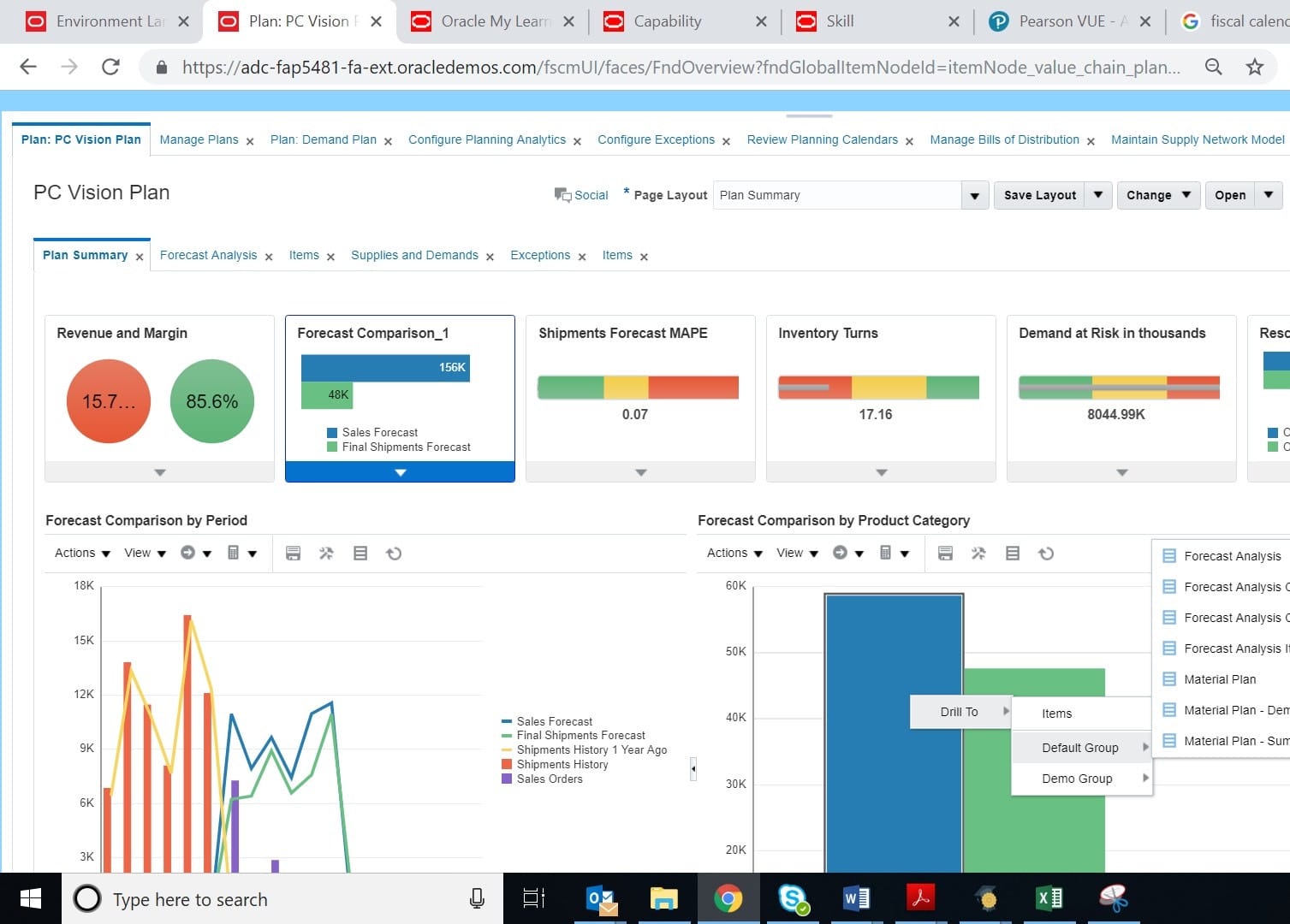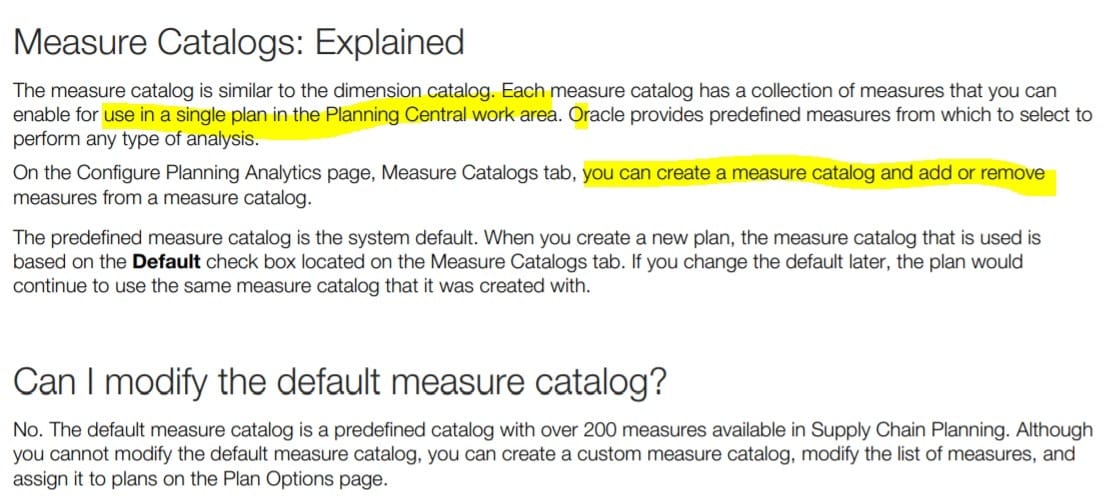1Z0-1066-22 Online Practice Questions and Answers

You have run a plan for your organization and there were sales orders that have been set up for drop shipment that you cannot see in the plan. Which two options explain why the sales orders cannot be seen in the plan? (Choose two.)
A. Drop Ship Item Validation Org has not been set up.
B. Drop Ship Demand Class has not be set up.
C. Supplier not configured in Manage Planning Source Systems
D. Include drop ship demands and supplies flag has not been checked on your plan options.
E. Planning Profile 'Enable Planning for Drop Shipments' has not been set to 'Yes'.
Which statement is correct regarding SandOP plan options?
A. Calculating Safety Stock can optionally be included.
B. Forecasting profile's input demand measure can only be set to 'consensus forecast' or 'approved consensus forecast'.
C. Supply Planning Mode 'aggregated' can be turned off.
D. Lead time compression can optionally be included as a legitimate plan constraint.
Your client wants their supply plans to have a customized group of exceptions. What two steps must you complete in order to make sure only these exceptions are included when running all of your client's supply plans? (Choose two.)
A. Manage Plans > Select each supply plan > Edit each supply plan > Manually add each exception specified by client
B. Configure Exceptions > Expand Supply Planning Exceptions > Highlight lines with exceptions specified by client > Click 'Add to Exception Set'
C. Configure Exception Sets > Create exception set > Add exceptions specified by client
D. Select 'Add to Supply Plan' button > Select which supply plans you want to have this group of exceptions
E. Manage Plans > Select each supply plan > Edit each supply plan > Add your exception set to Plan Options for each supply plan
During Implementation of Planning Central, your client has discovered that no Material Planners have been defined in Manage Material Planners in Planning Central.
In this situation, which three statements are true? (Choose three.)
A. Your client has not been assigned the Material Planner role.
B. You have not been assigned the Materials Planner role.
C. The Planner field will be null for all items.
D. Collect Planning Data has not been run for Material Planners.
E. Planned Orders will not release successfully.
What is one method of associating a Safety Stock Quantity value to an item?
A. Upload the value using File Based Data Import (FBDI)
B. Enter your value in the Safety Stock Quantity column in the Items page.
C. Run the Safety Stock Quantity Update Process.
D. Enter your value in the Safety Stock Quantity Override column in the Items page.
Your client has reviewed all of the current graphs available for the plans, but cannot find one that shows them exactly what they want for the Days of Supply. How can this key performance indicator be added?
A. Go to Configure Planning Analytics > Actions > Manage Tables, Graphs, and Analysis Sets, and edit the current 'Days of Supply' graph to meet the client needs.
B. Go to Configure Planning Analytics > Actions > Manage Tables, Graphs, and Analysis Sets, and add a new graph with the requested data.
C. Open the plan and go to Actions > Manage Tables, Graphs, and Analysis Sets, and edit the current 'Days of Supply' graph to meet the client needs.
D. It is not possible to add new or change the current graphs.
E. Open the plan and go to Actions > Manage Tables, Graphs, and Analysis Sets, and add a new graph with the requested data.
A sales order containing a back-to-back item has been created. However, when you ran the supply plan in Planning Central, the supply for the sales order was not released. Why was the supply not released?
A. The supply plan should have been run in Supply Chain Orchestration, not Planning Central.
B. Planning Central cannot create back-to-back supply, so the supply cannot be released.
C. Only Global Order Promising and Supply Chain Orchestration can be used to release and create new supplies for back-to-back orders.
D. The supply must first be created in Global Order Promising and then it can be released from Planning Central.
Which two statements are true when using Measure catalogs? (Choose two.)
A. The predefined measure catalog is not the system default.
B. The measure catalog has a collection of measures that you can enable for use in a single plan in the Planning Central work area.
C. You can restrict access to Measure Catalogs using Administer Data Security.
D. You can add or remove measures from a measure catalog.
E. Measure catalogs are defined in the system to improve the performance of the plan.
F. You navigate to Configure Measure Catalogs to edit the Catalog.
Which Statement is NOT correct regarding demand schedules when planning supply?
A. A demand schedule can be another Demand Plan, a Sales and Operations Plan, or a Production Plan.
B. A demand schedule's "End Item Demand" measure must be one of: Final Shipments Forecast, Final Bookings Forecast. Approved Final Shipments Forecast, or Approved Final Bookings Forecast.
C. An integrated demand and supply plan can have more than one demand schedule.
D. External forecast loaded from flat files can be a demand schedule.
Your client has operations in the west coast of the US. If the customer is in the western half of the US, then they would like to ship the product from their warehouses. If it's in the eastern half of the US, then they want to drop ship it from a supplier.
How would you recommend they set the assignment up?
A. Set up a region for the west coast warehouse and an item-region level assignment for the drop ship.
B. Set up two region level assignments, one for the west coast and the other for the east coast.
C. Set up by each customer for the customers who should get product from each warehouse.
D. Set up an item-region assignment for the west coast warehouse and a region level assignment for the drop ship.
E. Set up an item-organization assignment for the west coast warehouse and an item- organization level assignment for the drop ship.
You are viewing a drop shipment plan for your organization and you want to know which customer the purchase order will be shipped to. Where can you see that?
A. You need to first drill down to the sales order from the supply-demand link, then open the sales order to get the customer.
B. It is visible in the drop ship analytics.
C. It is not viewable at this time.
D. You can see the customer on the supply in Supplies and Demand.
E. You can see the supplier on the sales order, but not vice-versa.
You want to check how many items have excess inventory. Which three choices will get you there? (Choose three.)
A. Open Table, Graph, or Tile Set > Table: Item Exceptions Summary > Filter by Items with Excess Inventory
B. Manage Plans > Edit Plan Options > Select Supply tab > Navigate to Item area > Filter by Items with Excess Inventory
C. Open Table, Graph, or Tile Set > Table: Exceptions > Expand Supply Planning Exceptions > Select Items with Excess Inventory
D. Open Table, Graph, or Tile Set > Table: Items with Exceptions > Filter by Items with Excess Inventory
E. Open Table, Graph, Tile Set > Table: Items > Select any Item > Drill to: Item Exceptions > Expand Supply Planning Exceptions > Select Items with Excess Inventory > Refresh the search results
Which statement is true about the Production Scheduling Gantt chart?
A. The Gantt chart is read only, but you can change colors, sizing, and perform filtering.
B. You can view a Gantt chart or the Dispatch List, but not both at the same time.
C. The Gantt chart identifies idle time, changeovers, and downtime.
D. Metrics displayed above the Gantt chart include Late Demands, Late Work Order, Early Work Orders, and Changeover Time.
Each of your planners is responsible for a different geography and set of product lines, so each planner needs to see just their own set of data, analyses and dashboards.
How do you configure the application so each planner can have their own custom dashboard viewable only to themselves?
A. Create public page layouts that are tailored to specific business needs.
B. Create private page layouts that are tailored to specific business needs.
C. You cannot create custom dashboards by user.
D. Enable layout security checkbox in the Administer Planning Security
Demand is high leading up to the Christmas holiday every year between Dec 20 and Dec 24 and not on Christmas day (Dec 25). Your customer has two demand plans. Describe the steps to model Christmas causal factor in both demand plans.
A. Open a demand plan and add a new customer specific Christmas causal factor. Create a table displaying the causal factor measure and relevant time period and modify as required. Causal factor changes in this demand plan will reflect in the 2nd demand plan also.
B. Open a demand plan and add a new customer specific Christmas causal factor. Create a table displaying the causal factor measure and relevant time period and modify as required. Causal factor changes are plan specific, so repeat the steps in the 2nd demand plan.
C. Use FBDI to create a new customer specific Christmas causal factor. Place value of 1 from Dec 20 to Dec 34. Causal factor upload to one demand plan will reflect in the 2nd demand plan also.
D. Use FBDI to create a new customer specific Christmas causal factor. Place value of 1 from Dec 20 to Dec 24. Causal factor changes are plan specific, so repeat the steps in the 2nd demand plan.
E. Open a demand plan and edit Christmas casual factor measure. Place value of one from Dec 20 to Dec 24 and zero for non-impacted days including Dec 25. Causal factor changes in this demand plan will reflect in the 2nd demand plan also.
F. Open a demand plan and edit Christmas casual factor measure. Place value of one from Dec 20 to Dec 24 and zero for non-impacted days including Dec 25. Causal factor changes are plan specific, so repeat the steps in the 2nd demand plan.


